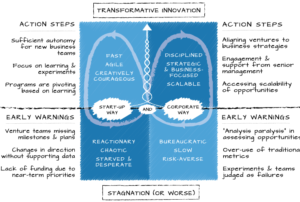Corporations and startups are often thought of as opposite ends of the spectrum, like oil and water. But remember: opposites attract. Collective disruption is about harnessing the power of two seemingly disparate groups and aligning the best of both worlds at each stage of the value creation process.
Some years back, a personal coach taught me about a personal and organizational development model called polarity thinking (www.PolarityPartnerships.com). The theory, developed by Dr. Barry Johnson, states that through our adult lives, most of us have progressed and succeed through effective “either/or” problem solving. For example, my engineering training instilled in me a thought process of defining the problem, identifying alternatives, and then arriving at the single best solution. But life today is much more complex than that. Many challenges aren’t solvable in the traditional sense, and we need to learn to leverage polarities as an ongoing process. In organizational design, a good example is decentralized approaches versus centralized approaches. Each has its advantages and its place, and each has a downside if over-focused as the “solution” to the neglect of the other.
In our context, the apparent paradoxes in corporate and entrepreneurial approaches are polarities that we can harness. Our job as business leaders is to leverage these corporate/entrepreneurial polarities in the context of our work. F. Scott Fitzgerald said, “The test of a first-rate intelligence is the ability to hold two opposing ideas in the mind at the same time and still retain the ability to function.”
I’ve used the Polarity Map to highlight polarities and how we can leverage them in the context of corporates and startups collaborating in transformative innovation and new business creation.
This model shows two neutral poles at either end of the horizontal axis. Using the metaphor of breathing, you need to both inhale and exhale. Neither is better or more important than the other. In our case, the horizontal axis is made up of the startup way and the corporate way. We need both, and they are interdependent.
The upper sections of the quadrant are the positive results of focusing on each of the respective poles. The positive results of focusing on the corporate way are more disciplined, strategic, and scalable opportunities. The positive results of focusing on the startup way are being fast, agile, and courageous (e.g., smart risk taking).
The lower sections of the quadrant are the negative results of over-focusing on one pole at the expense of the other. The negative results of over-focusing on the startup way are chaos, opportunism, and being starved (of money and resources). The negative results of over-focusing on the corporate way are being slow, bureaucratic, and risk averse.
The box at the top is the higher purpose – transformative innovation. It answers the question of “Why invest in leveraging this polarity?” It goes beyond the upside of each pole. This transformative innovation is customer and market focused. Similarly, at the bottom is the deeper fear – stagnation. If we don’t invest in managing this polarity, we end up with stagnation or, worse, decline and extinction.
The action steps in the figure below are ways that we can leverage the positive elements of each pole. Similarly, early warnings are indicators that we may be over-focusing and getting into the downside of a pole.
We need both the startup way and the corporate way to succeed at transformational innovation and new business creation. I believe that this is a powerful model for viewing corporate and startup collaboration. Multiple important polarities exist within this larger frame of corporate/ entrepreneurial collaboration. Other examples of polarities to leverage include autonomy/integration, risk taking/risk avoidance, and speed/discipline to name just a few.
In my book, Collective Disruption, I write extensively on how we can use the complementary strengths of each of these approaches in a virtuous circle of natural tensions. The collective disruption framework, which is laid out in detail in the book, is designed specifically to maximize the benefits of the interdependencies of these polarities from conception to scale-up and reintegration of new growth opportunities. I’ll be covering each element of the collective disruption framework at a high level in future blog posts.
In the meantime, I encourage you to consider purchasing the book right now. I recently launched a paperback edition and with it some rather enticing bonus packages. These bonuses are only good for book orders through June 30, so check them out now. You can find all the details here.










